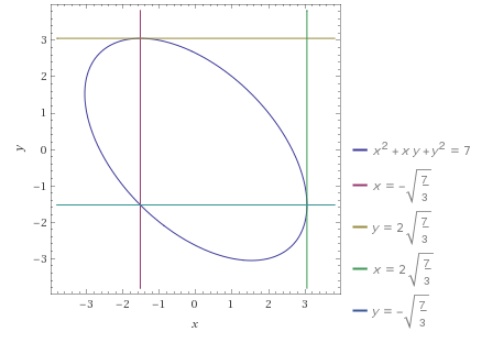How do you find all points on the curve #x^2 + xy + y^2 = 7# where the tangent line is parallel to the x-axis, and the point where the tangent line is parallel to the y-axis?
2 Answers
The tangent line is parallel to the
Explanation:
We'll start by finding
Now,
We have now, two equations:
Solve (by substitution)
Using
The tangent to the curve is horizontal at the two points:
(Observe that these pair do not also make the denominator of
To find the points at which the tangent is vertical, make the denominator of
We could go through the solution, but the symmetry of the equation that we will get:
and the points on the curve at which the tangent is vertical are:
By the way. Because we do have the technology, here is the graph of this rotated ellipse: (Note that
graph{x^2 + xy +y^2 =7 [-11.3, 11.2, -5.665, 5.585]}
Using only middle school math I get
Tangents parallel to the x axis at:
Tangents parallel to the y axis at:
Explanation:
I glanced at Jim's answer, which looks like a nice, standard calculus treatment. But I couldn't help but feel sad for all the middle schoolers out there in Socratic land who want to find tangents of algebraic curves but are still years away from calculus.
Fortunately they can do these problems using only Algebra I.
This might be a bit complicated for a first example, but let's go with it. We write our curve as
Let's take
We expand, but we don't expand the difference terms
We said
We sorted the terms by degree, and we can experiment with approximations to
Let's just generate some approximations to
That's not particularly exciting, but it correctly tells us points near
Let's get more interesting and keep the linear terms.
When we set this to zero, we get the best linear approximation to
We can consider other approximations as well:
These are higher order tangents, ones that college math students hardly ever get to. We've already gone beyond college calculus.
There are more approximations, but I'm being warned this is getting long. Now that we learned how to do calculus using only Algebra I, let's do the problem.
We want to find the points where the tangent line is parallel to the
We found our tangent line at
Parallel to the
Since
Similarly parallel to the y axis means
Check.
How to check? Let's do an Alpha plot .
plot x^2+xy+y^2=7, x=-sqrt{7/3}, y=2 sqrt{7/3}, x=2sqrt{7/3}, y =-sqrt{7/3}

Looks good. Calculus on algebraic curves. Pretty good for middle school.


